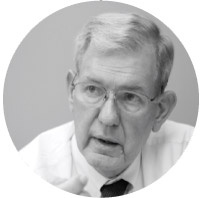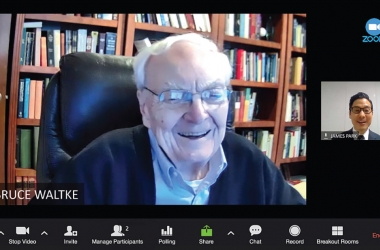The Eternal High Priest of the Covenantal Oath
(Book 6 of the History of Redemption Series)
Dr. Luder G. Whitlock, Jr
It was a great privilege to visit Pyungkang Cheil Church in Seoul, Korea in 2013 during the remarkable ministry of Dr. Abraham Park, author of the History of Redemption Series. As the chairman of Knox Theological Seminary at that time, it was one of the great honors of my life to award the honorary Doctor of Divinity degree to him in recognition of his global ministry. Dr. Park was a faithful servant of God, used globally to advance the Gospel. I was captivated by the global missionary vision of this church and its commitment to reach the world with the Gospel.
The most important thing for him was to know God’s will, and he developed an acute sensitivity to God’s guidance. Pyungkang Cheil Church was one of the most vibrant congregations that I have ever visited and that was because of the powerful ministry of Dr.
Park, who was not only a profoundly spiritual pastor but a gifted teacher who took the whole counsel of God seriously. That led him to emphasize the history of redemption in his preaching and teaching ministry. Since the publication of the first volume of the History of Redemption Series books in 2007, the fact that many scholars, including Dr. Bruce Waltke, one of the finest Old Testament scholars in the world, warmly endorsed this work attests to its value.
This theme of redemptive history provided a framework for the entire Bible so that his congregation could understand what they believed and why. He avoided the weakness of many pastors today who love and preach the Scriptures but fail to equip their congregations with the big picture of God’s plan and their place in it. As a result, although they clearly understand some basic truths, they fail to understand why biblical events unfolded as they did and how that should shape our understanding of the Scriptures and the church. Dr. Park taught the big picture so that his church members knew how all the smaller parts fit together.
Book 6 of the History of Redemption Series provides an excellent example of Dr. Park’s carefully developed methodology. He begins with an exposition of Deuteronomy and the sermons, or farewell addresses, of Moses, delivered in the plains of Moab just before the Israelites entered Canaan. He reminds us of God’s command in Deuteronomy 32:7, to “remember the days of old, consider the years of all generations.” He uses this to help the reader understand God’s history of redemption by the threefold command to remember, consider and ask: remember the past, reflect on the future, and decide or act in the present. God has been faithful to His covenant and He calls His people to faithfulness so that they may receive the abundance of His blessings.
The Eternal High Priest of the Covenantal Oath addresses the Chronicler’s genealogy as it is organized from a priestly perspective following the 70-year Babylonian captivity. It encourages the people of God, using the genealogies of the Old Testament, to remember their spiritual roots and the imperative of spreading God’s word to the nations. It also reveals the importance of restoring worship as a priority for God’s people as they returned to their homeland and started to rebuild. The Chronicler’s genealogy pointed to Jesus Christ, the promised eternal high priest first prophesied in Genesis 3:15. It explains the development of the priestly system that required sacrifices and culminated in the sacrifice of the eternal high priest, Jesus. Book 6 of the History of Redemption Series shows how the development of the priestly system reaches its climax in the ministry of Jesus, the great high priest. The Christo-centric nature of the Scriptures is plainly revealed. It becomes apparent that the shedding of His blood was necessary in order for our sins to be forgiven. Apart from the death and resurrection of Jesus, we would be condemned to remain outside the Promised Land or the New Jerusalem of Revelation 21 and 22. Dr. Park shows how an accurate understanding of the Jewish context, especially of early Christianity, is essential to an accurate interpretation of the Scriptures. They provide the framework for understanding the message of the New Testament. Important but seldom understood Biblical truths are clearly explained and accompanied by colored illustrations and a set of charts that will be invaluable to the reader who may otherwise fail to gain an understanding of the comprehensive Biblical and secular history that is presented.
Additional information is available regarding priestly garments and music. There may be a temptation to ignore them but that would be unwise.
As a young Christian, I would have benefited immensely from these volumes. As a new believer, I read the Bible seriously and memorized verses but it was not until I entered theological school that I began to grasp the significance of Biblical theology and redemptive history. In these volumes, Dr. Park makes redemptive history accessible to the lay Christian. Perhaps most significant is the lesson that today’s Christians should remember God’s work in history, how He has been faithful to those who trust in Him. That lesson should motivate contemporary Christians to renounce the world and all its temptations, trusting the Lord and obediently following Him. In doing so, the promises of God are assured and our sins are forgiven through the eternal sacrifice of Jesus.
Considering the history of Christianity in Korea, especially periods of great spiritual blessing, would it be too much to hope that attention to this volume, preferably the whole series, might be used to bring a new period of Scriptural understanding and spiritual blessing. More Christians need to read books like this one. I hope this volume touches off a new wave of interest in the Bible and illumines the path for God’s people everywhere.
Dr. Whitlock is recognized as one of the top five most influential seminary presidents in the latter half of the 20th century, and he served as the executive director for the publication of the New Geneva Study Bible. He received his D.Min. from Vanderbilt University.
*This post can also be read in 'Champyungan'. (http://champyungan.com/en/)


 Today’s Pit Is Tomorrow’s Blessing
Today’s Pit Is Tomorrow’s Blessing
 An Interview with Dr. Bruce K. Waltke, World-Renowned Theologian
An Interview with Dr. Bruce K. Waltke, World-Renowned Theologian









